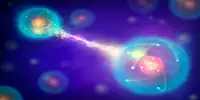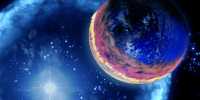In March, particle researchers presented tantalizing evidence for novel physics – maybe a new force of nature – at the Large Hadron Collider (LHC). Now, a new result from Cern’s massive particle collider, which has yet to be peer-evaluated, appears to back up the theory. The standard model is our current best theory of particles and forces, and it accurately represents what we know about the physical material that makes up the world around us. Despite the fact that the standard model is without a doubt the most successful scientific theory ever written down, we know it must be incomplete.
It is famous for merely describing three of the four fundamental forces: electromagnetic force, strong and weak forces, and gravity. It does not have an explanation for the dark matter that astronomers say dominates the universe, and it cannot explain how stuff survived the big bang. Most physicists believe that there must be more cosmic elements still to be discovered and examining a class of fundamental particles known as beauty quarks is one of the most promising ways to learn more about what is out there.
Beauty quarks, also known as bottom quarks, are fundamental particles that combine to form larger particles. Quarks come in six different flavors: up, down, weird, charm, beauty/bottom, and truth/top. Protons and neutrons in the atomic nucleus, for example, are made up of up and down quarks. Beauty quarks are unstable, only lasting 1.5 trillionths of a second on average before disintegrating into other particles. The presence of other fundamental particles or forces can have a big impact on how beautiful quarks decay. When a beauty quark decays, the weak force turns it into a collection of lighter particles, such as electrons. One way a new force of nature can reveal itself to us is by modifying the frequency with which beauty quarks decay into different types of particles.
The March publication used data from the LHCb experiment, which is one of four massive particle detectors that record the outcomes of the LHC’s ultra-high-energy collisions. (The letter “b” stands for “beauty” in LHCb.) It discovered that beauty quarks decayed at different rates into electrons and their heavier counterparts, muons. This was surprising because the muon, according to the conventional model, is essentially a carbon copy of the electron, except that it is roughly 200 times heavier. This means that all forces should exert the same amount of force on electrons and muons — when a beauty quark decays into electrons or muons via the weak force, it should do so equally frequently.
Instead, my colleagues discovered that muon decay occurs only around 85 percent as frequently as electron decay. If the discovery is right, the only way to explain such a phenomenon is if a new force of nature that pushes electrons and muons in opposite directions is interfering with the disintegration of beauty quarks. Particle physicists were ecstatic at the outcome. For decades, we have been looking for signs of something other than the standard model, but despite ten years of work at the LHC, nothing conclusive has been discovered. So discovering a new force of nature would be a tremendous thing, and it could ultimately provide answers to some of modern science’s most perplexing questions.















